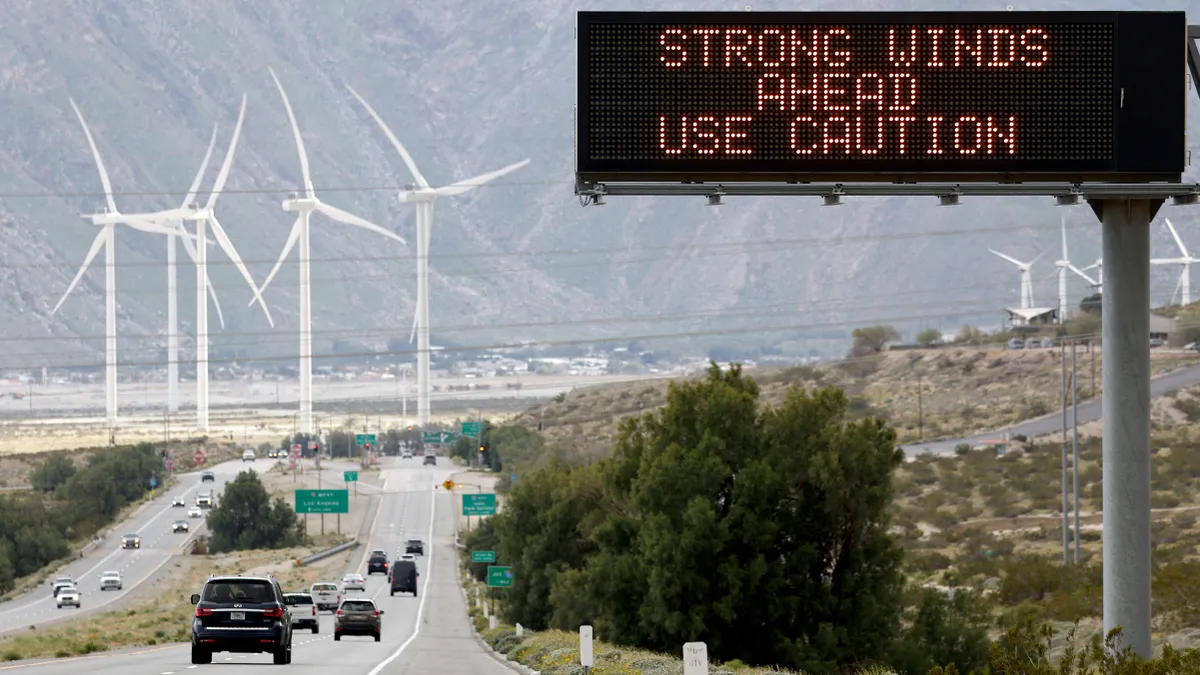Groundbreaking new affordability evaluation criteria and metrics to manage California’s skyrocketing electricity rates are a step forward but not enough, regulators and stakeholders agreed at the state's second annual electricity rates affordability conference Feb. 28.
Despite the falling costs of wind and solar generation, California’s electricity rates are rising due to costs related to wildfires, legacy assets, and public purpose programs, the California Public Utility Commission's 2019 Annual Affordability Report, published in April 2021, concluded. As a result, a “substantial number of households” face “a double burden of expensive service and a low ability to pay for it,” the report said.
The severity of California’s “affordability crisis” for low-income customers has yet to be measured, but it “is beginning to impact middle-class households,” Senior Policy Expert Jennifer Dowdell of ratepayer advocacy group The Utility Reform Network told Utility Dive. She applauded the new CPUC criteria and metrics and other conference input because “the state needs all parties’ proposals.”
There is “no panacea” for electricity affordability, and a “portfolio” of solutions will be needed, especially because “some cost drivers, like global fuel prices, are outside our control,” CPUC Commissioner Darcie Houck cautioned. The commission is studying the conference's many proposals for actions the state can take “for controlling costs and mitigating rates,” she added.
The Feb. 28 California affordability conference began with a discussion of the new evaluation criteria and metrics. But much of the content was about electricity ratemaking reforms, new ways to fund public programs, innovations in regulatory oversight, and a potential breakthrough in equity with redesigned fixed charges for low-income customers.
The criteria and metrics
With U.S. electricity rates rising in the last decade from the energy transition, and especially from the disruptions created by Covid-19, regulators in many states, including Pennsylvania, New York, Connecticut and Nevada, have been searching for ways to improve affordability and extend equity to low-income customers.
But California’s skyrocketing rates and high variable renewables penetrations make its work a guidepost for managing transition costs, conference participants told Utility Dive. Ordered by California’s 2018 affordability proceeding (R.18-07-006), the conference offered the most affordability innovation yet considered in any state, they said.
The CPUC’s six proposed evaluation criteria for managing rising electricity rates offer guidance on regulatory reforms related to affordability, equity, environmental and social justice, and utility revenue requirements and rates, CPUC Energy Division Regulatory Analyst for Electric Rates Jack Chang told the conference. They also consider the economics and feasibility of affordability proposals.
The commission’s three affordability evaluation metrics, based on its recently-approved Environmental and Social Justice Action Plan 2.0, start with the "Affordability Ratio," which shows energy’s portion of a household’s income. "Hours at Minimum Wage" measures the labor needed to pay for energy. The "Socioeconomic Vulnerability Index – Disadvantaged Communities" is a multi-factorial measure of community impacts.
Over 11% of California’s low-income households have Affordability Ratio values over 35%, which means energy costs over one-third of their discretionary income, the CPUC report found. “Median-income households can much more easily afford utility services” and this “stark disparity” may be “a warning sign” of low-income households' need for assistance, it added.
Some Californians are now forced “to choose between utility services and groceries,” featured speaker Abigail Solis, manager of sustainable energy solutions for low-income housing advocacy group Self-Help Enterprises, agreed. Regulators must prevent “catastrophic effects on vulnerable communities,” she said. And the California Alternative Rates for Energy, or CARE, and Family Electric Rate Assistance, or FERA, programs are not adequate, she added.
Reactions
Many conference participants endorsed the commission’s criteria and metrics with reservations. They are “really just good ratemaking and public policy that many states could benefit from,” said Regulatory Assistance Project Associate Mark LeBel. But because some proposed fixed charges and non-rate revenue sources could have unintended consequences, there must be a “realistic discussion of the downsides of each proposal, including my own,” he added.
Southern California Edison is “generally supportive” of the criteria and metrics, but affordability must not compromise safety, reliability and state climate, clean air and electrification goals, SCE Director of Pricing Design and Research, Robert A. Thomas emailed Utility Dive. Changes must also avoid potentially expensive “operational complexity,” he added.
The metrics will “require further testing and refinement prior to broad scale implementation” because understanding some may require a “steep learning curve,” San Diego Gas and Electric spokesperson Anthony Wagner emailed Utility Dive.
The criteria and metrics “can be useful,” but “traditional ratemaking principles” protect utility revenue requirements and attract vital investment capital, Pacific Gas and Electric Senior Vice President of Regulatory and External Affairs Robert S. Kenney also emailed.
It is reasonable to try to develop objective criteria and repeatable metrics, and equity is critical, California Energy Commission Commissioner J. Andrew McAllister told Utility Dive. But "one-size-fits-all ratemaking" may not suit California utilities’ revenue requirements and the state’s diverse geographies, ethnicities, climates and customer classes, he added.
This is “a unique time,” he cautioned. On April 3, California briefly reached a 97.3% renewables penetration and, as the state expands on that and on its economy-wide electrification goals, low-cost renewables will make generation “a smaller part of the overall bill and infrastructure a bigger part,” he said.
Affordability can, though, be addressed with traditional cost-based rates if they are proactively designed to protect vulnerable customers and to optimize the use of electrification, McAllister added.
There are three basic strategies for increasing affordability in California, according to Natural Resources Defense Council work presented to the conference by NRDC Senior Scientist, Climate & Clean Energy Program, Mohit Chhabra.
First, utilities’ total revenue requirements could be reduced by moving policy goals and public purpose programs out of rates, Chhabra said. California’s tax-supported General Fund might pay for wildfire mitigations and recovery and the CARE and FERA programs, and gasoline taxes could support new transmission and distribution to meet transportation electrification goals, he said.
“It is probably time to make some disciplined choices among the many ratepayer-funded programs,” Commissioner McAllister agreed. But that cannot be an excuse to end cost-effective programs, he stressed.
The goal is to keep electricity rates low enough to encourage building and transportation electrification and allow renewables-generated electricity to replace fossil fuels for heating and driving, both East Bay Community Energy VP of Public Policy and Deputy General Counsel Melissa Brandt and SDG&E Senior VP of Customer Services and External Affairs Scott Crider agreed.
Funding public purpose program costs through state taxes instead of through electricity rates would not solve the affordability problem completely, but it would alleviate some rate pressure, Brandt told the conference.
Legislative action is needed to remove public purpose program costs, which have “increased 130% in the last 10 years,” from “the backs of our customers,” Crider added.
Funding policy objectives from non-ratepayer sources, though possible, might make them “subject to legislative and political uncertainties,” Chhabra said. But a multiple-source hybrid approach that incorporates funding from taxes, securitized debt, shareholder capital, public infrastructure investments, or reduced utility returns can be effective, he added.
A “holistic approach to ratemaking” is what the commission is broadly working toward, CPUC Commissioner Houck said.
Affordability can also come through more electrification, which would spread fixed infrastructure costs in rates over more kWh without increasing peak demand costs, Chhabra said, laying out the group's second strategy for increasing affordability. And if costs for system upgrades to manage electrification’s higher kWh volumes are kept low enough, falling rates can start a “virtuous cycle” of affordability, he added.
NRDC found current California rates are not low enough to accelerate customer investments in, or support utility incentives for, things like heat pumps and electric vehicle chargers, Chhabra said.
Smart rate designs can drive electrification and "strategically grow utility revenues enough to put downward pressure on rates,” CEC Commissioner McAllister added without specifically endorsing the NRDC proposal.
Rate components, like time of use rates and specific fixed charges, can be reallocated to support affordability and equity, the Regulatory Assistance Project’s LeBel agreed. A time-of-use rate for all customers with a very low off-peak price is a first simple step, and a tiered monthly fixed residential customer charge of $0 for low-income customers, $5 for middle-income customers, and $10 for high-income customers would add equity, he proposed.
A fixed “site infrastructure charge” for distribution system costs could be added for higher usage residential customers and those with distributed energy resources like rooftop solar and batteries, LeBel added. And a fixed “distribution flow charge” could spread costs further through higher prices for kWh usage than for exported kWh credits, he said.
Such fixed charges in the rate design, though not without controversy, could improve affordability and equity in a way that also protects state climate and clean energy goals, many conference participants acknowledged.
Fixed charges
California has long resisted fixed charges and imposed a statutory limit on them because they can be regressively burdensome to low-income customers with limited ability to manage electricity usage.
But NRDC found “income-based fixed charges have the biggest potential impact” on affordability, Chhabra said. And resistance to fixed charges can be eliminated “if the charge is income-based and designed to increase bills significantly for only high-income customers,” he said.
Potential fixed charge rate reforms were welcomed by SCE’s Thomas and PG&E’s Kenney. “It is time to evolve rate structures,” and the income-based fixed charge is “intriguing,” CEC Commissioner McAllister agreed.
Economists with the University of California, Berkeley, Energy Institute at Haas proposed a widely-discussed income-based fixed charge in 2021.
"The cost burden on lower-income households is substantial” under California’s current “extremely regressive” rates and income-based fixed charges can ease that burden, Haas Faculty Director Meredith Fowlie told the conference.
The Haas theory is sound, but its three tiers of charges, which go up to $74 per month for some customers, “raise the feasibility question,” Chhabra said. With NRDC’s five fixed charge tiers, “low-income earners benefit most,” and “the middle three tiers either benefit or are neutral,” Chhabra said.
There are challenges to implementing an income-based fixed charge, both Chhabra and Fowlie acknowledged. Utilities would likely need cooperation from the state’s Franchise Tax Board to prevent people from abusing the system, but that might present information privacy issues or lead to bureaucratic complexities, they said.
Two innovative changes to regulatory oversight outside of NRDC’s three strategies for increasing affordability were proposed by other conference participants.
Regulatory oversight innovation
A potentially simple oversight change would require each utility's General Rate Case to include a second spending plan for only what the utility would prioritize if spending was limited to the rate of inflation, TURN’s Jennifer Dowdell said.
This hypothetical inflation-limited spending “is not a cap on utility spending, it is a context,” Dowdell told the Feb. 28 conference.
Utilities are required to use a commission-ordered Risk-Spend Efficiency metric to prioritize program proposals, Dowdell told Utility Dive. If those priorities and costs are clear in the General Rate Case record, a regulatory review can compare outcomes from approved spending with what inflation-constrained spending would have provided, she said.
Like other participants, TURN’s intent is not to limit or discourage utility investments in safety and reliability, Dowdell added. All the proposals have merit and deserve evaluation, "even if some do not meet the commission’s feasibility criterion."
But reforms to other regulatory processes are needed to “contain utility costs,” California Solar and Storage Association Policy Director Brad Heavner insisted during the conference. The commission should order a “Targeted Energy Dispatch” program requiring better utility dispatch of local distributed resources to reduce infrastructure investments that drive rate increases, he said.
It should also employ its new feasibility criterion to evaluate the conference proposals, Heavner told Utility Dive. Many of the rate reform proposals are “politically unrealistic” and will not be accepted by lawmakers or consumers, he said.
Both the CEC’s McAllister and the CPUC’s Houck applauded the conference participants for taking on the controversial topic. “It was a vital conversation,” McAllister said.
“The most important takeaway is the wide agreement that rates cannot keep increasing at recent years' double-digit percentages,” added Houck. There is a growing urgency for “concrete measures to constrain utility costs and their impacts on ratepayers.”
The conference input will lead to a Q1 2023 CPUC staff proposal for improving affordability that will be the basis of the CPUC’s affordability rulemaking report to Governor Gavin Newsom, Houck said.






















